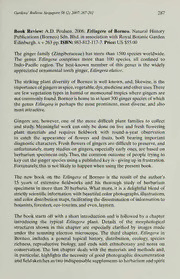
Etlingera of Borneo by A.D. Poulsen PDF
Preview Etlingera of Borneo by A.D. Poulsen
Gardens'Bulletin Singapore58 (2) 2007:287-292 287 Book Review: A.D. Poulsen. 2006. Etlingera of Borneo. Natural History Publications (Borneo) Sdn. Bhd. in association with Royal Botanic Garden Edinburgh, x + 263 pp. ISBN: 983-812-117-7. Price: US $55.00 The ginger family (Zingiberaceae) has more than 1500 species worldwide. The genus Etlingera comprises more than 100 species, all confined to Indo-Pacific region. The best-known member of this genus is the widely appreciated ornamental torch ginger, Etlingera elatior. The striking plant diversity of Borneo is well known, and, likewise, is the importanceofgingersasspice,vegetable,dye,medicineandotheruses.There are few vegetation types in humid or monsoonal tropics where gingers are not commonlyfound. Borneo is home to at least 300 ginger species ofwhich the genus Etlingera is perhaps the most prominent, most diverse, and also most attractive. Gingers are, however, one of the more difficult plant families to collect and study. Meaningful work can only be done on live and fresh flowering plant materials and requires fieldwork with round-a-year observation to catch the appearance of flowers and fruits, both bearing important diagnostic characters. Fresh flowers of gingers are difficult to preserve, and unfortunately, many studies on gingers, especially early ones, are based on herbarium specimens only. Thus, the common outcome of people trying to key out the ginger species using a published key is - giving up in frustration. Fortunately,this is not likely to happen when using the present book. The new book on the Etlingera of Borneo is the result of the author's 15 years of extensive fieldworks and his thorough study of herbarium specimens in more than 20 herbaria. What more, it is a delightful blend of strictly scientific information with beautiful color photographs,illustrations, and color distribution maps,facilitating the dissemination ofinformation to botanists,foresters, eco-tourists, and even,laymen. The book starts off with a short introduction and is followed by a chapter introducing the typical Etlingera plant. Details of the morphological structures shown in this chapter are especially clarified by images made under the scanning electron microscope. The third chapter, Etlingera in Borneo, includes a general topical history, distribution, ecology, species richness, reproductive biology, and ends with ethnobotany and notes on conservation. The last chapter deals with the materials and methods and, in particular, highlights the necessity of good photographic documentation andfield sketches as two indispensable supplements to herbarium and spirit 288 Card.Bull.Singapore58(2)2007 materials.The last few pages,just before the revision itself, are occupied by a key to the Bornean species of Etlingera. The main part ofthe book features 42 taxa all together. Sixteen species, one subspecies, one variety, and one combination are described. Each species is accompanied by relevant information about the source of publication, synonymy, nomenclatural details, and the type(s). This is followed by a thorough species description, local names and uses, etymology, ecology and habitat, distribution (supported by colour map clearly showing the locality of type specimen), conservation status, list of materials examined, and ends by elaborate notes helping to pinpoint the differences of the species under discussion from its closest taxa, or discussing the tricky issues of nomenclatural history and taxonomic confusions. Just before the book concludes, there is a big bonus for all botanists printed between the sections of references and indices to scientific and vernacular names. It is a list of identification of all Etlingera specimens examined by the author during the course of his preparation work, alphabetically sorted according to a collector's surname, followed by the collection number of species. In case you get stuck in research, for example, with a sheet of specimen collected by GobilikJ. etal. 738 kept at SAN Herbarium,you will know within seconds ofchecking this book that the species ofthe specimen on this sheet is E. inundata. I tried to find negative points in this new book,however, it turned out to be atoughjob.As atrue gingerfan,I wouldwelcome the more than25 pages of introduction part ofthe book. Nonetheless,information about ethnobotany of various Etlingera species is rather little, despite the fact that more than 20 species are used for various purposes. The Table 1 (p. 18) reported uses and number ofspecies used for aparticularpurpose,e.g.,shootis eatenin20 species,but the readerisnot informedwhich species are these without going through all the taxa listed.An appendix with an overview of all species and their uses would have been useful. To facilitate the use of the identification key, more illustrations explaining the various morphological terms would have been welcome because the perception of various structures seen in gingers traditionally deviates from the definition of botanical terms used in other monocot groups. To note, the flower structure is explained well, however, the terms regarding leaf terminology would be particularly useful, ifillustrated. In my opinion,it remains as a matter offact,that it is faster and much more Gard.Bull.Singapore58(2)2007 289 enjoyable to identify a species while leisurely flipping through the pages full of stunning and beautiful photographs, including close-up details of each species, rather than using the dichotomous key to the species. I have a feeling that most ginger specialists will use the species key published in the new book only for the first few times to satisfy their curiosity rather than using the key as a regular tool for species identification. Last but not least, it is always necessary to remind ourselves that in our quickly disappearing plant world today, it is difficult to protect something that we do not know properly, nor recognize, and neither can we identify. This published revision study of the genus Etlingera is therefore a much welcome step forward, enabling us to protect the endemic and endangered species ofa group ofprominent gingers in Borneo. Etlingera of Borneo is definitely a benchmark publication. It shall serve in many years to come as a great example and guide, showing how a modern revision ofa complicated genus should be done. Jana Leong-Skornickova The SING Herbarium Singapore Botanic Gardens 1 Cluny Road Singapore
